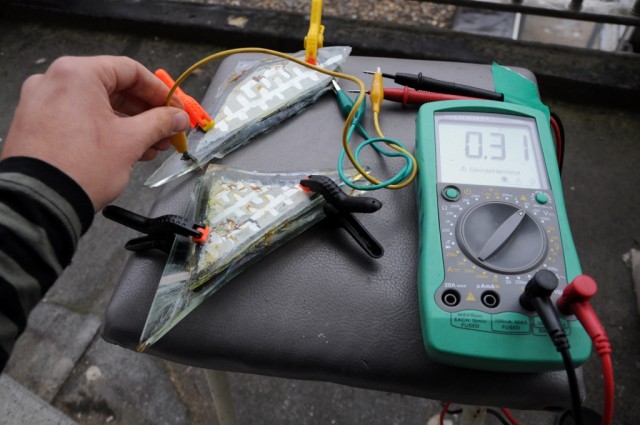
| Anhang | Größe |
|---|---|
| 9.64 MB |
Friday, Saturday
7th, 8th Sept. 2012- Start: 10:00 am
Solar workshop
how to make your own solar cells?
The goal of the solar workshop is to create an independent and more or less permanent source of energy for artworks in public space. With a constant need for electricity that digital media have, an independent source of energy allows for these devices to work without maintenance and usual limitations of the proximity of an electrical source or the length of a battery life.
At the workshop, we will use only organic material to produce dye-sensitized solar cells, based on the process patented by prof. Michael Graetzel who won the Millennium Technology Prize for this invention. We will extract energy from readily available materials - like glass, berries or thee, graphite, betadine. Each cell produces about 0.4V of energy in bright sunlight.
Next to the cells, we will construct devices that can run on very low energy, so that they can be powered by our cells. We will make things that send invisible information in the electromagnetic spectrum - like low-power radio transmitters or xbees.
Making the cells is a fun and imperfect process, as not all the cells will give the same power. With joint forces at the workshop we should produce at least 10 cells that can be connected together to meet energy requirements of a device.
selena savic
was born in belgrade, in 1980. she graduated from architecture at the faculty of architecture, university of belgrade in 2006 and from a master in media design, piet zwart institute, rotterdam, the netherlands in 2010. currently working on her doctoral thesis “construction and mediation of social/public space through communication technology” at epfl, lausanne, switzerland and ist lisbon portugal. for works, see work / radi. for exhibitions, presentations and other events, see recent / upravo se desilo.
url: http://kucjica.org/
----
Further Research of the Workshop
did some web-research on the cells, that we produced. The dye needed for grätzel-cells is called anthocyanin or Anthocyane in German. Is is mainly contained in red, blue, violett or black fruits or flowers. I learned from this article - in German only:
http://www.faz.net/sonntagszeitung/wissenschaft/ein-hauch-von-hibiskus-1...
The German and English-Wikipedia-sites varies about the data of plants containing anthocyanine. I collected the most promissing results of plants: http://en.wikipedia.org/wiki/Anthocyanin
Elderberryjuice - Holunderbeersaft 1900-6600 mg/kg
http://en.wikipedia.org/wiki/Sambucus
Acai Juice
http://en.wikipedia.org/wiki/A%C3%A7a%C3%AD_palm
Aronia - Apfelbeere (Saft)
http://en.wikipedia.org/wiki/Aronia
So, maybe these would be good choices for next experiments. I guess I will test it, when I am back home.
Oh, and I found a very precise description of all production steps here, unfortunatly, again it is in german, only:
http://www.science-forum.de/download/skript_graetzelmittel.pdf
